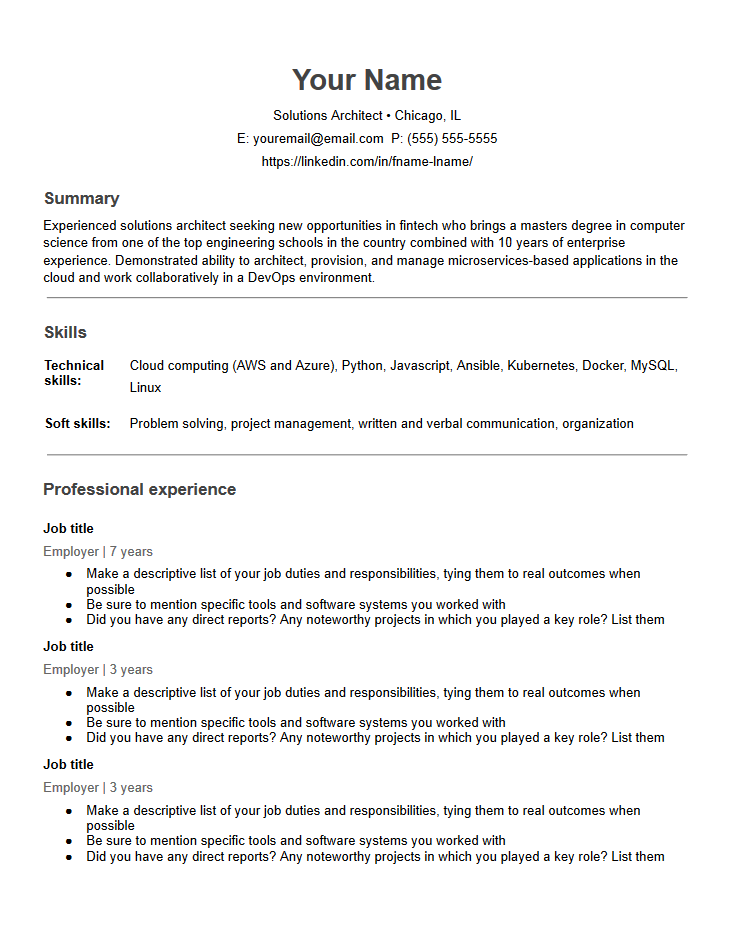
Whether you’re just starting out as a solutions architect or you’re looking for your next opportunity, a strong resume will help you stand out among applicants. But how do you write a solutions architect resume? What sections should you include? How long does it need to be? In this article, we’ll answer all these questions and more, even throwing in a free resume template to sweeten the deal. Let’s jump in!
Table of contents
Solutions architect resume template
Here’s a free resume template to get you started. To make this template your own, open the Google Docs link below and click “File” > “Make a copy” to save to your own Google account. If you prefer to use a different word processor, click “File” > “Download” and choose from one of the options in the dropdown menu.
How to write a solutions architect resume
It may seem strange to think of a resume as something that you write, but the truth is, making a resume involves a good bit of writing. Here are the main sections you should include in your resume with tips to help you write them.
Personal information
This is the section at the very top of your resume where you include details such as your name, email address and phone number, location, and LinkedIn profile. Optionally, you can also include a link to your personal website or GitHub profile. Some people are tempted to include a professional headshot in this section, but unless you work in entertainment, this is unnecessary.
Summary or objective
Below your personal information, write a brief summary or objective to highlight important aspects of your experience and to give recruiters a sense of what you’re looking for in a new position.
> Ask the Expert: Using ChatGPT to Write Your Cover Letter
This section should be two to three sentences long at most, and you should use strong adjectives and verbs to describe your background. Start with what you’re looking for in a new job before elaborating on what makes you a strong candidate. Also try to tailor this section of your resume to the job description, if possible.
Skills
We’ll get more into some specific skills you might include in this section in a little bit, but for now, know that you should break this section down into two subsections. The order doesn’t matter, but employers like to see a good mix of technical and soft skills. Technical skills could be programming languages or tools you’re proficient in, while soft skills could be time management, problem solving, or communication.
Work experience
This is probably the most misunderstood part of the resume writing process. Far from just being a place to list your past job experience with bullet points describing your responsibilities at each position, this is your chance to show recruiters how you made a difference at each job you’ve held.
The most important piece of advice here is to quantify your work experience. That means add numbers wherever and whenever possible. Did you contribute to a project that reduced application downtime and improved performance? Include metrics.
> 22 Solution Architect Interview Questions With Answers
Just as with interview questions, use the STAR method. STAR stands for situation, task, action, and result, and it’s a great framework for helping you write the experience section. You have less space for text in the work experience section than you have time to speak in an interview, so focus more on the action and results part of STAR if you need to save space.
Education
This section is relatively straightforward. Starting with postsecondary education (university or college), list your education history in chronological order, with most recent experience at the top. In lieu of the years attended, some people prefer to indicate the number of years attended in an effort to curb hiring bias.
Licenses and certifications
Again, we’ll take a closer look at this in a moment, but when you list your licenses and certifications, be sure to include the title, the issuing body, the date issued, and the license or certificate ID, if applicable. As with education, list this in chronological order with the most recent at the top. If you have many licenses and certifications, pick five to seven of the most relevant ones to the job you’re applying for.
Publications (optional)
Publications are a great thing to be able to include on your resume. If you’ve ever had something you wrote published in a technical blog or website, it’s a good idea to include that on your resume. Showcasing your publications adds credibility to your resume and tells recruiters that you’re a subject matter expert in your area.
Accomplishments or awards (optional)
Have you won any awards or had a big hand in any successful major projects? Include them on your resume! As with the experience section, be sure to list the actions and outcomes for your accomplishments following the STAR method.
Tip: You may have heard before to limit your resume to one page, but not so fast! In many cases, recruiters prefer multi-page resumes, especially if you’re more advanced in your career.
Solutions architect skills to put on your resume
As with any section of your resume, always be true to your experience when writing the skills section. But in general, here are some of the most common skills employers look for in a solutions architect hire.
| Soft skills | Technical skills | ||
|---|---|---|---|
| Problem solving | Cloud infrastructure like AWS, Microsoft Azure, and Google Cloud Platform (GCP) | ||
| Project management | Programming languages like Javascript, Python, and C# | ||
| Written and verbal communication, particularly the ability to clearly communicate technical concepts to non-technical audiences | DevOps best practices and DevOps automation tools like Ansible, Jenkins, and Chef | ||
| Organization and documentation | Infrastructure design best practices—for instance, architecting according to the Well-Architected Framework when working with AWS | ||
| Container tools like Kubernetes, Terraform, and Docker | |||
| Microservices architecture | |||
| Cloud cost optimization best practices | |||
| Relational databases like Microsoft SQL Server, Oracle Database, Amazon RDS, MySQL, and IBM Db2 | |||
| Operating systems like Linux and UNIX |
Best solution architect certifications
There are a number of different certifications out there for solutions architects. Here are some good options to explore for beefing up your resume:
- AWS Solutions Architect – Associate/Professional
- Project Management Professional (PMP) certification
- Certified Scrum Master (CSM)
- Microsoft Certified Solutions Expert (MCSE)
- The Open Group Architecture Framework (TOGAF)
Your turn
Now that you have a killer resume template and the knowledge to make it your own, it’s time to open a word processor and get to work. Remember to tailor your resume to every job you apply for, and be sure to triple check for typos. Paired with a solid cover letter and good interview prep, you’re well on your way to accomplishing your career goals.
The #1 platform for cloud jobseekers
Create your Nerdly profile today, and join a rapidly growing community of the best cloud professionals on the market.

Related articles
Ensuring Cloud Security and Compliance with NerdRabbit’s Audits Pod
Ensuring the security and compliance of your cloud infrastructure is more critical now than ever. As companies migrate to the cloud, they face many challenges, from maintaining visibility and navigating complex solutions to evading sophisticated cyberattacks....
The Ultimate Guide to AWS Cloud Practitioner Certification: Everything You Need to Know
The AWS Certified Cloud Practitioner certification is an excellent starting point for individuals looking to validate their knowledge of the AWS Cloud, independent of specific technical roles. Whether you are a non-technical professional, a student, or someone in the...
Optimize Your Cloud Strategy: Evaluating Your Cloud Team for Peak Performance
Having a skilled and well-aligned cloud team is essential for any organization aiming to leverage cloud technologies to their fullest potential. An optimized cloud team can drive innovation, reduce costs, and enhance overall business performance. But how do you ensure...







